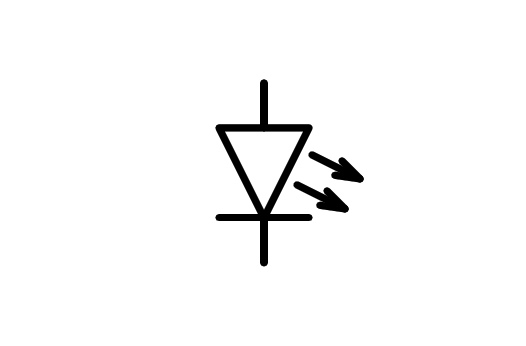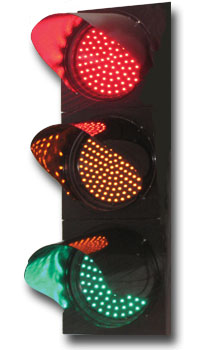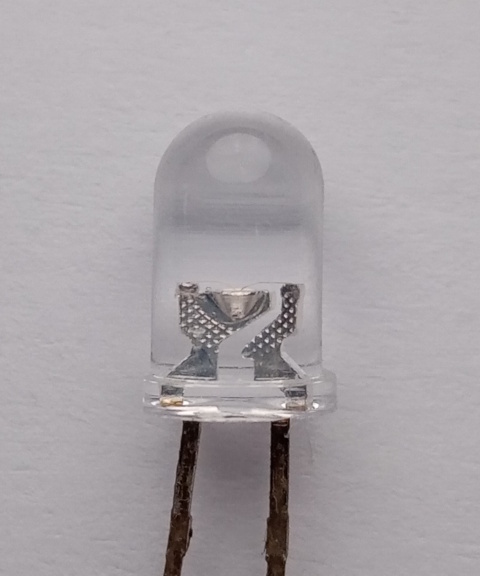5. The LED diode¶
The LED diode is a light emitting diode (Light Emitting Diode). There are versions of various colors, from the infrared LEDs in remote controls to the ultraviolet LEDs in the plastic resin curing lamps used by dentists.

LED diode symbol.¶

Traffic light based on colored LEDs.¶
Everywhere we can see red, green or blue LEDs acting as pilot lights in all types of electronic devices or in traffic lights.
White LEDs have become increasingly more efficient, replacing traditional incandescent filament lamps years ago.
LEDs are based on a technology that is still progressing today, for example, in the OLED screens of the latest generation televisions and smartphones.
LED polarization¶
Normally LEDs have a fixed operating voltage that cannot be exceeded and is lower than the supply voltage. To prevent the LED from burning out, we must insert a resistor in series that will limit its operating current.
In the following simulation we can see a diagram of an LED flashlight based on three 1.5 volt batteries in series and a white LED with a working voltage of 3 volts with a current of 50 milliamps. The bias resistance is 30 ohms.

Cylindrical white LED, 5 millimeters in diameter.¶
Polarization resistance calculation¶
To calculate the necessary resistance to polarize the LED correctly, you must use the following formula:
Where the variables are:
R = LED polarization resistance in ohms [Ω].
V_cc = Supply voltage in volts [V].
V_led = Working voltage of the LED diode in volts [V].
I_led = Working current of the LED diode in amperes [A].
- Example 1:
We need to calculate the bias resistance of green LED of a computer keyboard. Its working voltage is 2.2 Volts, its working current is 10 milliamps and the supply voltage is 5 volts.
Applying the formula:
- Example 2:
We need to calculate the bias resistance of the white LED that illuminates a smartphone screen. Its working voltage is 3 volts, its working current is 150 milliamps and the supply voltage is 3.6 volts.
Applying the formula:
Exercises¶
Draw the electrical diagram of a flashlight with an LED diode. Use the symbol at the beginning of the unit, with two arrows indicating the light output of the diode.
Calculate the polarization resistance of the red LED of a mouse knowing that the working voltage is 1.8 volts, the working current is 16 milliamps and the supply voltage is 5 volts.
Check with the circuit simulator that the calculation is correct.
Don't forget to change the operating voltage of the LED, editing the LED... Create New Simple Model... Forward Voltage 1.8 ... Current At Above Voltage (A) 0.016 ... OK.
Calculate the polarization resistance of a car light composed of two white LEDs in series that have a working voltage of 3 volts each and a working current of 20 milliamps. The supply voltage is 12 volts.
Check with the circuit simulator that the calculation is correct.
Don't forget to change the operating voltage of the LEDs, editing each LED... Create New Simple Model... Forward Voltage 3.0 ... Current At Above Voltage (A) 0.020 ... OK.
Extension¶
- Look for information on the multiplexing of LEDs in common anode and common cathode, widely used in 7-segment displays.
- Learn what connecting LEDs is with the charlieplexing technique to light multiple LEDs with few control lines.